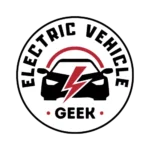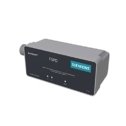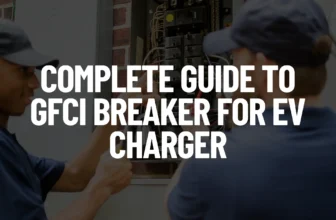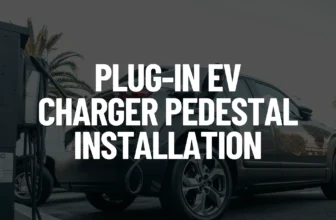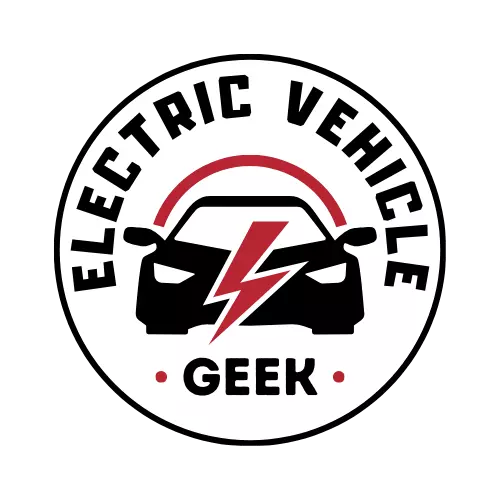EV charger surge protection is essential for safeguarding your EV charger installation from high-voltage electrical surges, shocks, and other circuit irregularities
Installing a surge protection device (SPD) helps protect your EV charger and EV charging accessories by redirecting sudden voltage spikes to ground before they reach sensitive EV charging accessories connected to the EV charger’s branch circuit. This prevents damage, ensures consistent power delivery, and reduces downtime during charging.
Surge protection is especially recommended if your area experiences grid instability or if you have a renewable energy EV charger setup, such as solar EV charging, where voltage levels may fluctuate during transitions between power sources.
Without protection, voltage spikes in the EV charger’s branch circuit can damage the EV charger’s internal circuitry, connected EV charging accessories, and, in extreme cases, the vehicle’s onboard charging system, which mainly features its surge protection measures
A surge protector works by safely diverting excess voltage away from the EV charger and wiring, helping to maintain consistent performance and reliable charging.
Table of Contents
- Understanding Power Surges in EV Charger Installations
- EV Charger Surge Protection Devices
- Do EV Chargers Require Surge Protection?
- How EV Charger Surge Protection Works
- SPD Connection in EV Charger Setups
- EV Charger Surge Protection by Power Supply Type
- Conclusions.
Understanding Power Surges in EV Charger Installations
EV charger installations are exposed to voltage disturbances that can degrade performance, damage electrical components, or even cause complete EV charger failure. Understanding the types and sources of power surges is critical when designing a safe and reliable EV charging setup.
Types of Surges Affecting EV Chargers Installations
EV charger installations are typically exposed to three main types of power surges:
Transient Surges
Transient surges are short, high-voltage spikes that last microseconds but can cause long-term damage. In EV charger installations, transient surges often originate from utility grid switching or nearby lightning activity. They can silently wear down internal charger components, such as control boards, relays, and communication interfaces.
Switching Surges
Switching surges occur when the EV charger, or its power sources, such as solar inverters, battery storage systems, generators, or renewable energy systems, start or stop drawing or supplying current.
In complex EV charger installations involving solar EV charging, bidirectional EV charging, or generator-fed EV charging, rapid switching events can introduce voltage transients into the system. In homes where the EV charger shares a panel with other inductive loads like HVAC systems or well pumps, these switching surges can cycle repeatedly. Over time, they may degrade the EV charger’s internal electronics or even damage the vehicle’s onboard charging components.
Lightning Surges
Though less frequent, lightning strikes, especially in outdoor EV charger installations, can introduce tens of thousands of volts into the system. Whether through direct hits or nearby ground strikes, the surge energy can travel along service lines, EV charger branch circuit, or through the grounding system, instantly damaging the EV charger, home electrical panel, or even the EV.
EV Charger Surge Protection Devices
There are three main types of EV charger surge protection devices (SPDs): Type 1, Type 2, and Type 3. They are classified by installation location, protection function, and performance. Each type plays a specific role in safeguarding residential and light-commercial EV charging systems in North America.
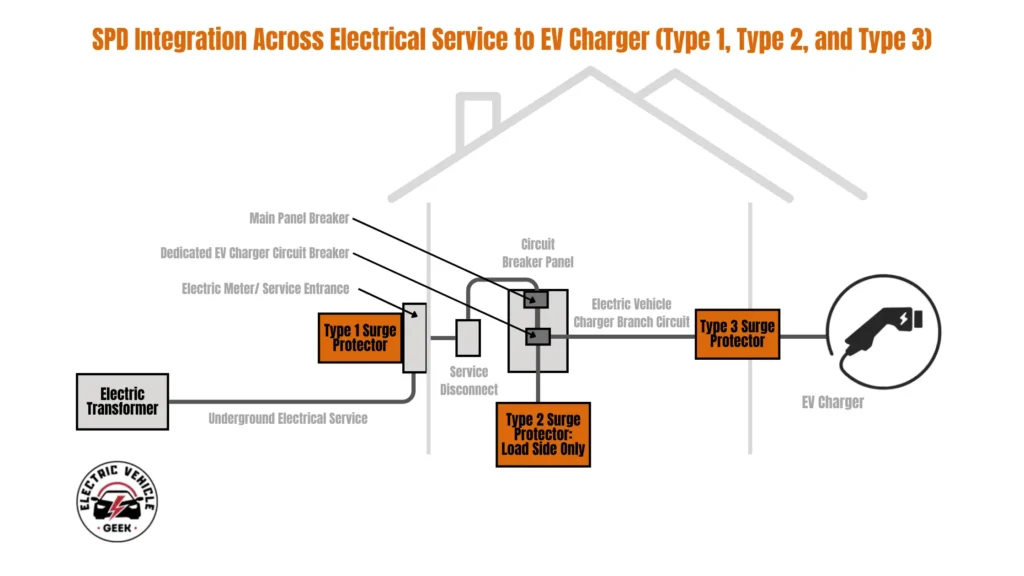
Type 1 Surge Protection Devices (Type 1 SPD)
Type 1 SPDs protect against high-energy surges from external sources, such as direct lightning strikes and utility faults on overhead lines.
Type 1 SPDs are installed ahead of the main breaker, either at the service entrance or meter socket, and are ideal for systems with overhead utility feeds or external lightning protection systems. For EV charging installations, especially in lightning-prone areas or sites with multiple EVSE units, Type 1 SPDs offer primary surge protection by clamping dangerous voltages before they reach distribution panels, branch circuits, or connected EV chargers.
Type 2 Surge Protection Devices (Type 2 SPD)
Type 2 surge protective devices (SPDs) safeguard against indirect lightning strikes, utility grid switching transients, and internal electrical disturbances. They are typically installed at the main service panel or a dedicated subpanel near the EV charger, commonly in locations such as a garage, utility room, or outdoor-rated load center, providing localized protection for branch circuits serving Level 1 and Level 2 EV charging equipment.
This is the most appropriate choice for residential and light commercial EV charger installations.
Type 3 Surge Protection Devices (Type 3 SPD)
Type 3 SPDs provide point-of-use protection and are installed directly at the EV charger as an EV charger security feature or installed on an EV charging outlet. They are often built into the EVSE or used as plug-in surge protectors, offering low let-through voltage. However, Type 3 SPDs are not a standalone solution and must be used in combination with a Type 2 or Type 1 SPD upstream.
Best Surge Protection Types for EV Charger Installations
For home EV chargers, which mainly consist of 120V Level 1 EV chargers and 240V Level 2 EV chargers, whether you’re installing a hardwired EV charger or using a plug-in EV charger, we recommend installing a Type 2 surge protection device (SPD) at the subpanel closest to the EV charger. SPD protects against utility switching surges and indirect lightning strikes.
For commercial or multi-unit EV charger installations, such as Level 3 EV chargers or high amperage Level 2 EV chargers where chargers are fed directly from the main distribution panel, we recommend a Type 1 or combined Type 1/2 SPD. Type 1 units handle direct lightning and high-energy utility faults, which is critical if the building has overhead service or is in a lightning-prone area. A combination unit gives you both upstream and downstream protection in one device.
For extra protection right at the EV charger, we suggest adding a Type 3 SPD at the point of use. Many EV chargers already have Type 3 SPD built in, especially smart Level 2 EV chargers; however, a Type 3 SPD is only effective when used with a properly installed Type 1 or Type 2 SPD upstream.
Level 1 EV Charger Surge Protector
Level 1 EV charger surge protectors are typically installed at the main AC distribution panel (120/240V service). Level 1 EV chargers operate on 120V AC power and draw 12 to 16 amps, delivering continuous loads of approximately 1.4 to 1.9 kW.
Here are some of the best Level 1 EV charger surge protectors we recommend:
Level 2 EV Charger Surge Protector
Level 2 EV chargers operate on 208V to 240V AC circuits and require appropriate surge protection to prevent damage from voltage spikes. A surge protection device (SPD) should be installed near the point of use, either close to the EV charging outlet for plug-in EV chargers or near the junction box, EV charger pedestal, or EV charger lock box for hardwired EV chargers.
The best Level 2 EV charger surge protector devices we recommend include:
Siemens Boltshield FSPD140 Whole-House SPD for EV Charger Protection
Siemens Boltshield FSPD140 Whole-House SPD for EV Charger Protection
The Siemens BoltShield FSPD140 is our top recommended surge protection device (SPD) for EV charger installations. We recommend it for setups involving a single EV charger, multiple EV chargers, or a charger paired with smart accessories that require circuit-level protection. When installed properly, close to the main electrical panel’s primary breaker, the FSPD140 provides whole-panel surge protection for all branch circuits, including those supplying EV charging equipment and accessories.
Level 3 EV Charger Surge Protector
Level 3 EV chargers are the most expensive on our list, requiring three-phase 208V to 480V AC input power and delivering the fastest DC fast charging speeds. We recommend installing Level 3 EV charger surge protectors near the point of use, including at the power cabinet and the charging dispenser, to protect critical AC and DC components from high-energy surges.
The best Level 3 EV charger surge protector we recommend includes:
Do EV Chargers Require Surge Protection?
Yes, EV charger installations require surge protection, especially when considering safety, reliability, and long-term cost savings. For example, a standard Level 1 or Level 2 charger in the United States operates on 120V or 240V, but if a power surge exceeds this voltage range, it can damage the EV charger, the vehicle’s onboard charging system, and even pose a fire hazard.
73.7% of Americans experience power outages, and 80% of major U.S. outages are weather-related. Yet even in less storm-prone states like Ohio, EV charger installations remain at risk. Improper wiring, aging components, and physical wear can all trigger dangerous voltage spikes.
Power surges in EV charger installations can result from multiple causes, including:
- Lightning strikes, whether directly or indirectly affecting your EV charger installation, can induce powerful voltage surges through overhead or underground power lines, potentially damaging the charger, the vehicle’s onboard charging system, or even causing electrical fires.
- Grid fluctuations during power outages or switching operations between renewable energy systems and grid EV charging.
- Internal EV charger branch circuit faults, such as faulty EV charger wiring, aged components, or exposed ground cables.
Repeated small surges known as transient overvoltages, in an EV charger branch circuit, can gradually degrade EV chargers, wiring, and the vehicle’s onboard charging system, often without immediate signs of failure.
Complex branch circuits involving solar, battery storage, or bidirectional charging commonly include components that generate low-level surges. Inverter noise, while a well-known source of interference, is just one of several causes of transient overvoltages in these setups.
Without proper surge protection, these transient events can damage the consumer unit, EV charger, connected accessories, and even the vehicle’s charging components, including onboard electronics. In many cases, warranty claims are denied when surge-related damage is unmitigated, leaving homeowners with costly repairs or replacements.
How EV Charger Surge Protection Works
In residential EV charger installations, surge protection devices (SPDs) are typically installed at the main service panel or a dedicated EV subpanel. This provides branch-circuit-level protection for the entire EV charging system, including the charger, wiring, and connected accessories.
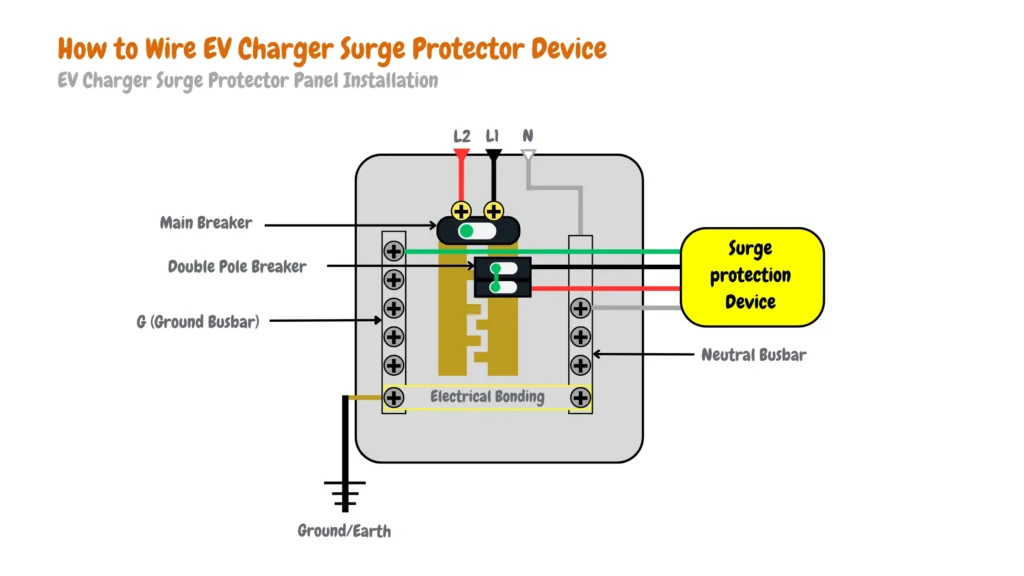
These SPDs use Metal Oxide Varistors (MOVs), semiconductor components that respond within nanoseconds to voltage spikes. When a surge occurs, the MOVs clamp the excess voltage and safely redirect it to the EV charger grounding system, protecting sensitive components such as the EV charger, wiring, and control electronics.
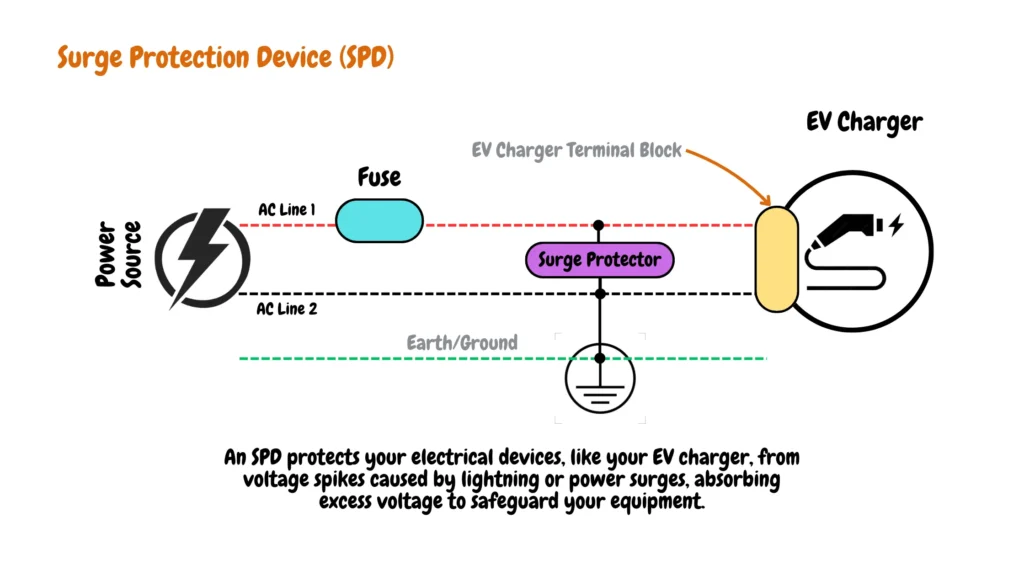
When a voltage spike occurs, the MOV activates almost instantaneously (within nanoseconds), clamping the voltage to a safe threshold and diverting the excess energy to ground via the EV charger grounding system. This protects critical components such as the EV charger, circuit wiring, and onboard control electronics.
SPD Connection in EV Charger Setups
Proper SPD connection is essential in EV charger setups to protect against voltage spikes, utility disturbances, and switching surges, especially when multiple EV charging accessories, such as smart controllers or contactors, are present in the branch circuit.
In complex or multi-charger systems, these components are often housed within Power Switchgear and Controlgear Assemblies (PSC-assemblies), which integrate breakers, disconnects, meters, and SPDs into a unified enclosure. This configuration ensures coordinated protection, improved reliability, and compliance with standards like IEC 61439 and NEC 230.67.
Single SPD Connection for Single EV Charger Setups
In typical residential installations with a single EV charger, one SPD is installed to protect the dedicated branch circuit. The SPD can be configured in series or parallel with the circuit breaker, depending on the enclosure type and space constraints:
Series Configuration SPD
In this configuration, the SPD is installed in series with the dedicated EV charger’s circuit breaker. This setup provides continuous filtering of transient disturbances and is typically used in installations with non-metallic panels or plastic EV charger lockboxes, where SPDs and dedicated EV charger circuit breakers are installed.

Parallel Configuration SPD
In this configuration, the SPD is installed in parallel with the dedicated EV charger’s circuit breaker. It activates only during a surge event, making it ideal for residential or light-commercial installations. This setup is typically used with metallic panels or metal EV charger lockboxes, where the enclosure, when properly bonded and grounded, contributes to effective surge diversion and grounding, in compliance with safety standards.

Multiple SPD Connections for Commercial or Multi-EV Charger Installations
Multiple SPD installations are essential in commercial buildings, workplaces, apartments, and multi-dwelling units (MDUs), where multiple EV chargers share a dedicated EV charger subpanel or common enclosure housing SPDs and EV charger circuit breakers. These setups require distributed surge protection to manage higher load complexity, shared infrastructure, and increased exposure to electrical disturbances.
Series-Connected SPDs
Installed in series with the dedicated circuit breaker, these SPDs filter all current flowing to the EV charger. They are used in commercial setups with sensitive loads. They are more commonly found in plastic enclosures or plastic EV charger lockboxes, where both dedicated EV charger circuit breakers and SPDs are installed.
Parallel-Connected SPDs
Installed in parallel with the EV charger circuit breaker, but often arranged in series with other SPDs at various protection levels (e.g., service panel, subpanel, and device level) for each dedicated EV charger. This configuration is ideal for metallic enclosures and metal EV charger lockboxes, where the enclosure, when properly bonded and grounded, can function as part of the protective grounding system, supporting effective surge diversion and ensuring compliance with electrical safety standards.
EV Charger Surge Protection by Power Supply Type
Split-Phase 120/240V Residential Panel Surge Protection Wiring (U.S. NEC Standard)
In typical North American EV charger installations, the most common configuration is the Split-Phase 120/240V residential panel, compliant with NEC standards. This setup features two hot wires (L1 and L2), a neutral, and a ground. It supports 120V Level 1 EV charging and 240V Level 2 EV charging.

Surge protection is typically installed across the two hot legs (L1-L2) at the main panel close to the power source to protect the entire home, including the dedicated EV charger branch circuit. The charger itself may be connected via a NEMA 14-50 outlet or hardwired to a junction box, both protected by a dedicated EV charger double-pole breaker. Proper EV charger grounding and neutral-to-ground bonding at the main panel are essential for system safety and code compliance.
120V Single-Phase EV Charger Surge Protection Wiring
For Single-Phase 120V EV charger installations, commonly used for Level 1 charging, surge protection can be installed line-to-neutral (L-N) and line-to-ground (L-G) to safeguard the entire electrical panel and all connected devices, including the EV charger.

High-Leg Delta EV Charger Surge Protection Wiring
A high-leg delta system supports both 120V Level 1 EV charging (from L1 or L3 to neutral) and 240V Level 2 charging (between any two phases). To provide comprehensive surge protection, a Type 2 SPD should be connected using a three-pole breaker across L1, L2, and L3, ensuring protection for all branch circuits and connected equipment within the panel.

Wye EV Charger Surge Protection Wiring
Wye (or Star) configurations are common in the U.S., primarily in commercial and industrial EV charger installations. These systems support a range of voltages suitable for various EV charging levels:
- 120V (L-N) for Level 1 EV charging (from 208Y/120V Wye systems)
- 208V (L-L) for Level 2 EV charging
- 277V (L-N) is not typically used for EV charging but may power control systems or lighting circuits within EVSE setups
- 480V (L-L) from 480Y/277V Wye can support Level 3 DC fast charging (via DCFC power supplies with AC input)
In Wye (Star) systems, surge protection devices (SPDs) are installed across all phases (L1, L2, L3), neutral (N), and ground (G) to protect EV chargers and other equipment from voltage transients. These systems support 120V, 208V, 277V, and 480V circuits, commonly used in commercial EVSE installations.

A Type 2 SPD is typically connected at the panel using a 4-pole breaker to protect all branch circuits, including those serving EV chargers. The SPD must be properly rated for the system voltage, such as 208Y/120V or 480Y/277V.
Why Install EV Charger Surge Protection Devices?
Installing a Surge Protection Device (SPD) in your EV charger branch circuit is a critical safety and cost-protection measure.
Protects Against Lightning and Grid-Induced Surges
Whether installed indoors or outdoors, EV charging stations are vulnerable to voltage spikes caused by lightning, even if the strike is not direct. Utility-related issues such as switching surges, voltage drops, and short outages can also lead to sudden overvoltage conditions. These events can damage your EV charger’s branch circuit components and sensitive electronics in your EV charger and electric vehicle.
Shields from Internal Faults and Inverter Issues
Transformers in the local grid can fail, releasing massive surges. Likewise, solar inverters or home battery systems tied into your EV charging setup can cause unpredictable voltage fluctuations. These internal faults pose real risks to your EV charging system’s reliability and safety.
Reduces Cost of Repairs and Enhances Equipment Longevity
Surge-related damage can result in costly repairs or complete replacement of the electric vehicle charger branch circuit, EV charger, or sensitive electric vehicle charging electronics, including the onboard charging unit. A quality SPD offers inexpensive, long-term protection that can extend the lifespan of your EV charging equipment, often by years.
Improves Safety and Compliance
Unprotected surges can not only cause electric vehicle branch circuit equipment and accessories to fail but may also lead to electrical fires. Installing surge protection significantly reduces these safety hazards. In some regions, surge protection is also required by local codes or NEC recommendations, especially when the EV charger is installed far from the main panel.
Maintains Warranty Coverage
Most EV chargers and EV manufacturers include clauses excluding coverage for surge-related damage. Installing a certified SPD in your electric vehicle charger branch circuit may be necessary to maintain warranty eligibility for both your EVSE and the vehicle’s charging system.
Conclusions.
In conclusion, proper surge protection for EV chargers is essential to safeguard both your vehicle and charging equipment. Whether using Level 1, Level 2, or Level 3 EV charger surge protectors, each offers a different level of protection against voltage spikes that can damage the main panel, EV charger branch circuit, charger, and connected accessories.
Investing in a quality EV charging surge protection device ensures the longevity and reliability of your EV charger installation and gives you peace of mind knowing your investment is protected from electrical hazards.

James Ndungu is a certified EV charger installer with over five years of experience in EVSE selection, permitting, and installation. He holds advanced credentials, including certification from the Electric Vehicle Infrastructure Training Program (EVITP) and specialized training in EV charging equipment and installation, as well as diplomas in EV Technology and Engineering Fundamentals of EVs. Since 2021, James has tested dozens of EV chargers and accessories, sharing expert insights into the latest EV charging technologies.
Last update on 2025-11-30 / Affiliate links / Images from Amazon Product Advertising API
